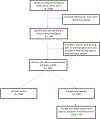Relationship of Preeclampsia With Maternal Place of Birth and Duration of Residence Among Non-Hispanic Black Women in the United States
- PMID: 33563008
- PMCID: PMC7887058
- DOI: 10.1161/CIRCOUTCOMES.120.007546
Relationship of Preeclampsia With Maternal Place of Birth and Duration of Residence Among Non-Hispanic Black Women in the United States
Abstract
Background: Preeclampsia is one of the leading causes of maternal mortality in the United States. It disproportionately affects non-Hispanic Black (NHB) women, but little is known about how preeclampsia and other cardiovascular disease risk factors vary among different subpopulations of NHB women in the United States. We investigated the prevalence of preeclampsia by nativity (US born versus foreign born) and duration of US residence among NHB women.
Methods: We analyzed cross-sectional data from the Boston Birth Cohort (1998-2016), with a focus on NHB women. We performed multivariable logistic regression to investigate associations between preeclampsia, nativity, and duration of US residence after controlling for potential confounders.
Results: Of 2697 NHB women, 40.5% were foreign born. Relative to them, US-born NHB women were younger, in higher percentage current smokers, had higher prevalence of obesity (body mass index ≥30 kg/m2) and maternal stress, but lower educational level. The age-adjusted prevalence of preeclampsia was 12.4% and 9.1% among US-born and foreign-born women, respectively. When further categorized by duration of US residence, the prevalence of all studied cardiovascular disease risk factors except for diabetes was lower among foreign-born NHB women with <10 versus ≥10 years of US residence. Additionally, the odds of preeclampsia in foreign-born NHB women with duration of US residence <10 years was 37% lower than in US-born NHB women. In contrast, the odds of preeclampsia in foreign-born NHB women with duration of US residence ≥10 years was not significantly different from that of US-born NHB women after adjusting for potential confounders.
Conclusions: The prevalence of preeclampsia and other cardiovascular disease risk factors is lower in foreign-born than in US-born NHB women. The healthy immigrant effect, which typically results in health advantages for foreign-born women, appears to wane with longer duration of US residence (≥10 years). Further research is needed to better understand these associations.
Keywords: body mass index; cardiovascular diseases; preeclampsia; prevalence; risk factors.
Figures
Comment in
-
Addressing Inequities in Cardiovascular Disease and Maternal Health in Black Women.Circ Cardiovasc Qual Outcomes. 2021 Feb;14(2):e007742. doi: 10.1161/CIRCOUTCOMES.121.007742. Epub 2021 Feb 10. Circ Cardiovasc Qual Outcomes. 2021. PMID: 33563006 Free PMC article. No abstract available.
References
-
- Fingar RK, Mabry-Hernandez I, Ngo-Metzger Q, Wolff T, Steiner AC, Elixhauser A. Delivery Hospitalizations Involving Preeclampsia and Eclampsia, 2005–2014: Statistical Brief #222. In: Healthcare Cost and Utilization Project (HCUP) Statistical Briefs. Agency for Healthcare Research and Quality (US); 2017. Accessed November 1, 2020 https://www.ncbi.nlm.nih.gov/books/NBK442039/#sb222.s1
Publication types
MeSH terms
Grants and funding
LinkOut - more resources
Full Text Sources
Other Literature Sources




